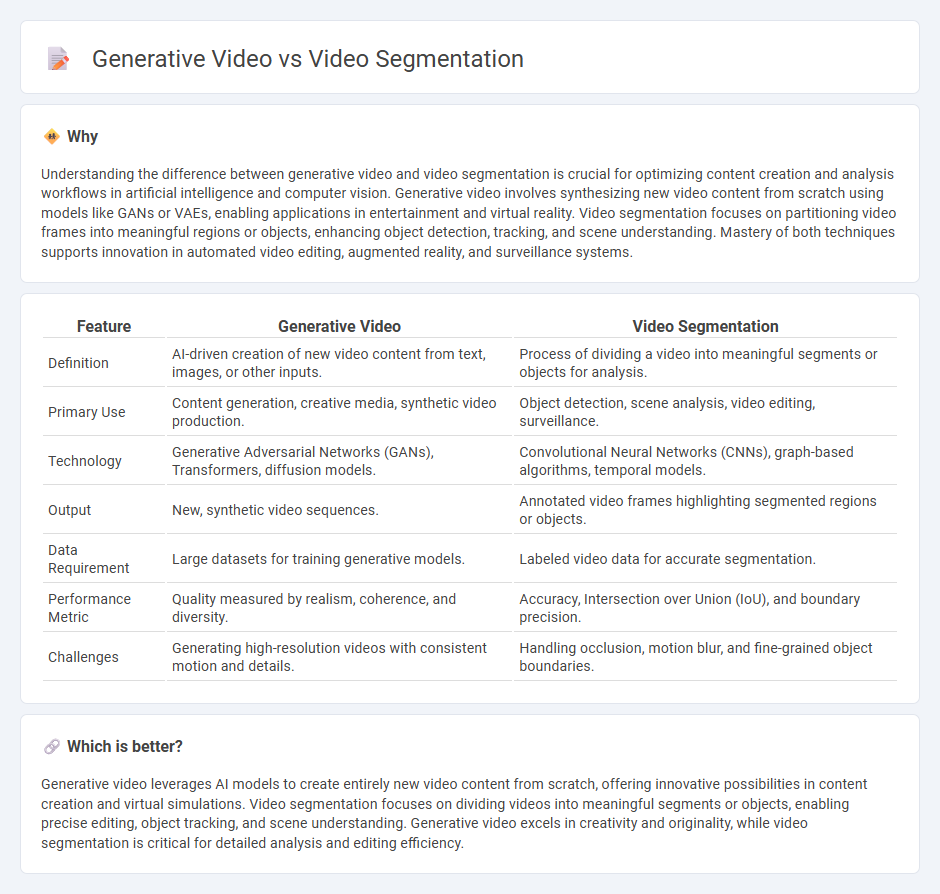
Generative video technology leverages AI models to create entirely new video content by synthesizing frames based on input data, enhancing creativity in film, gaming, and virtual reality. Video segmentation involves dividing video frames into meaningful regions or objects for applications such as object tracking, scene understanding, and video editing. Explore the distinct capabilities and applications of generative video and video segmentation to better understand their impact on modern digital media.
Why it is important
Understanding the difference between generative video and video segmentation is crucial for optimizing content creation and analysis workflows in artificial intelligence and computer vision. Generative video involves synthesizing new video content from scratch using models like GANs or VAEs, enabling applications in entertainment and virtual reality. Video segmentation focuses on partitioning video frames into meaningful regions or objects, enhancing object detection, tracking, and scene understanding. Mastery of both techniques supports innovation in automated video editing, augmented reality, and surveillance systems.
Comparison Table
| Feature | Generative Video | Video Segmentation |
|---|---|---|
| Definition | AI-driven creation of new video content from text, images, or other inputs. | Process of dividing a video into meaningful segments or objects for analysis. |
| Primary Use | Content generation, creative media, synthetic video production. | Object detection, scene analysis, video editing, surveillance. |
| Technology | Generative Adversarial Networks (GANs), Transformers, diffusion models. | Convolutional Neural Networks (CNNs), graph-based algorithms, temporal models. |
| Output | New, synthetic video sequences. | Annotated video frames highlighting segmented regions or objects. |
| Data Requirement | Large datasets for training generative models. | Labeled video data for accurate segmentation. |
| Performance Metric | Quality measured by realism, coherence, and diversity. | Accuracy, Intersection over Union (IoU), and boundary precision. |
| Challenges | Generating high-resolution videos with consistent motion and details. | Handling occlusion, motion blur, and fine-grained object boundaries. |
Which is better?
Generative video leverages AI models to create entirely new video content from scratch, offering innovative possibilities in content creation and virtual simulations. Video segmentation focuses on dividing videos into meaningful segments or objects, enabling precise editing, object tracking, and scene understanding. Generative video excels in creativity and originality, while video segmentation is critical for detailed analysis and editing efficiency.
Connection
Generative video leverages artificial intelligence models to create new video content by synthesizing frames, while video segmentation divides videos into meaningful regions or objects, enabling precise manipulation of specific elements. This segmentation data is essential for generative video algorithms to isolate and modify distinct video components, improving the realism and coherence of generated content. Advances in video segmentation techniques directly enhance the quality and accuracy of generative video applications, such as virtual reality, film production, and video editing.
Key Terms
Object Detection
Video segmentation precisely identifies and isolates objects within video frames, enabling detailed object detection by classifying individual pixels or regions based on their semantic content. Generative video models create or predict video frames, often enhancing object detection by synthesizing realistic scenes that improve training datasets for detection algorithms. Explore further to understand how these technologies optimize object detection in dynamic visual environments.
Frame Synthesis
Video segmentation divides a video into meaningful regions or objects by analyzing frame content, enhancing object tracking and scene understanding. Generative video employs frame synthesis techniques to create new frames, improving video interpolation, prediction, and quality enhancement. Explore advanced frame synthesis methods to better understand the capabilities and applications of video segmentation and generative video technologies.
Semantic Masking
Video segmentation involves partitioning video frames into meaningful regions based on semantic content, enabling precise object identification and tracking. Generative video utilizes deep learning models to create or modify video sequences, often leveraging semantic masking to isolate and manipulate specific regions for enhanced realism or creative effects. Explore the latest advancements in semantic masking techniques to unlock new possibilities in video editing and generation.
Source and External Links
Video Segmentation: Intro, Methods, Tutorial - V7 Labs - Video segmentation is the process of dividing videos into segments based on features like object boundaries, motion, or scene changes, supporting tasks such as object tracking and scene understanding.
Introducing Meta Segment Anything Model 2 (SAM 2) - SAM 2 is a unified model enabling fast, precise segmentation of any object in videos or images with just a click, box, or mask, and can track objects interactively across frames with real-time performance.
Video Object Segmentation | Papers With Code - Video object segmentation is a binary labeling task that separates foreground objects from the background in video sequences, with recent advances focusing on interactive, modular, and efficient frameworks for both single and multiple object segmentation.
 dowidth.com
dowidth.com